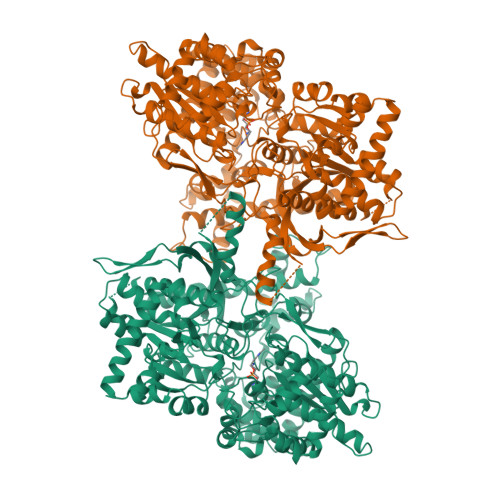Effects of commonly used cryoprotectants on glycogen phosphorylase activity and structure.
Tsitsanou, K.E., Oikonomakos, N.G., Zographos, S.E., Skamnaki, V.T., Gregoriou, M., Watson, K.A., Johnson, L.N., Fleet, G.W.(1999) Protein Sci 8: 741-749
- PubMed: 10211820
- DOI: https://doi.org/10.1110/ps.8.4.741
- Primary Citation of Related Structures:
1B4D, 1BX3 - PubMed Abstract:
The effects of a number of cryoprotectants on the kinetic and structural properties of glycogen phosphorylase b have been investigated. Kinetic studies showed that glycerol, one of the most commonly used cryoprotectants in X-ray crystallographic studies, is a competitive inhibitor with respect to substrate glucose-1-P with an apparent Ki value of 3.8% (v/v). Cryogenic experiments, with the enzyme, have shown that glycerol binds at the catalytic site and competes with glucose analogues that bind at the catalytic site, thus preventing the formation of complexes. This necessitated a change in the conditions for cryoprotection in crystallographic binding experiments with glycogen phosphorylase. It was found that 2-methyl-2,4-pentanediol (MPD), polyethylene glycols (PEGs) of various molecular weights, and dimethyl sulfoxide (DMSO) activated glycogen phosphorylase b to different extents, by stabilizing its most active conformation, while sucrose acted as a noncompetitive inhibitor and ethylene glycol as an uncompetitive inhibitor with respect to glucose-1-P. A parallel experimental investigation by X-ray crystallography showed that, at 100 K, both MPD and DMSO do not bind at the catalytic site, do not induce any significant conformational change on the enzyme molecule, and hence, are more suitable cryoprotectants than glycerol for binding studies with glycogen phosphorylase.
Organizational Affiliation:
Institute of Biological Research and Biotechnology, The National Hellenic Research Foundation, Athens, Greece.

















